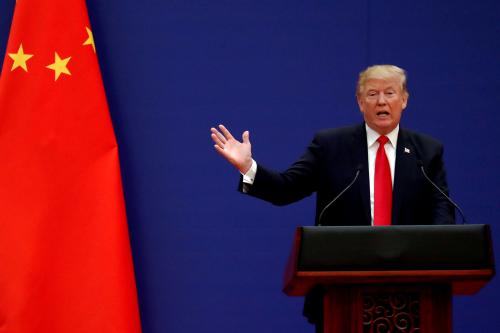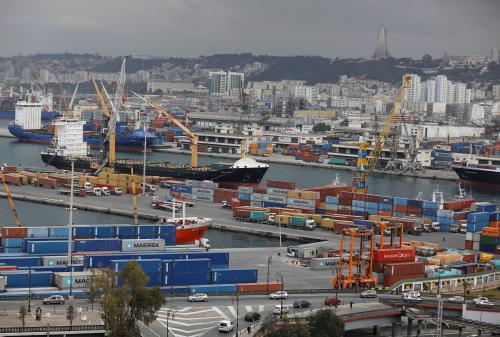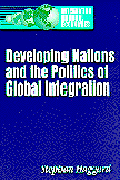On July 24, Landry Signé testified before the United States International Trade Commission on U.S. trade and investment with sub-Saharan Africa.
Good morning! I am Landry Signé, a David M. Rubenstein Fellow with the Africa Growth Initiative at the Brookings Institution. I am honored and grateful to testify on the recent developments of regional integration efforts in sub-Saharan Africa, especially the progress around the negotiation and implementation of the African Continental Free Trade Area.
As most of you know, on May 30, 2019, the African Continental Free Trade Area (AfCFTA or CFTA) came into force. With the recent signing by Africa’s largest economy, Nigeria, all but one of Africa’s 55 countries have joined (even if more need to ratify).
The significance of the AfCFTA cannot be overstated: It will be the world’s largest free trade area since the establishment of the World Trade Organization (WTO) in 1994. My research has shown that the AfCFTA will have a significant impact on manufacturing and industrial development, tourism, intra-African cooperation, economic transformation, and the relationship between Africa and the rest of the world, including the United States. For example, in a publication, I estimate that, under a successfully implemented AfCFTA, Africa will have combined consumer and business spending of $6.7 trillion in 2030, creating a unique opportunity for U.S. businesses.
UNECA has predicted that the implementation of the AfCFTA will raise intra-African trade by 15 to 25 percent, or $50 billion to $70 billion, by 2040, compared to an Africa without the AfCFTA. The International Monetary Fund (IMF) similarly projects that, under the AfCFTA, Africa’s expanded and more efficient goods and labor markets will significantly increase the continent’s overall ranking on the Global Competitiveness Index. Increased market access, in turn, is expected to enhance the competitiveness of industries and enterprises, the exploitation of economies of scale, and the efficacy of resource allocation.
The extent to which the AfCFTA will reduce barriers to intra-African (and international) trade is largely linked to the two phases of the ongoing negotiations. More specifically, Phase 1 is close to completion and includes the Protocol on Trade in Goods (including tariff concession schedules and rules of origin), the Protocol on Trade in Services (including a Most Favored Nations (MFN) clause—not automatic and reciprocal, should be agreed, which is problematic—exceptions and schedule on specific commitments), and the Protocol on the Settlement of Disputes. Phase 2 still needs to be completed, and will include the Protocol on Competition Policies, Protocol on Intellectual Property, and Protocol on Investment1.
Given the transformational potential of the AfCFTA for Africa, in this testimony, I present four points related to the AfCFTA and its relevance for U.S.-Africa trade and investment relations.
- African countries will start trading through the African Continental Free Trade Area as of July 1, 20202. What will happen between now and July 1, 2020? The period between now and start of trading will be used to create the conditions for successful implementation of the AfCFTA at the national, regional, and continental levels, including finalizing the remaining negotiations, producing relevant trade documents (by state parties), developing cooperation frameworks on trade facilitation (with RECs), and mobilizing the private sector. The state of preparedness will also be reviewed (meeting of Director General). This timeline also allows time for businesses to expand investments in production and logistics in order to be to be able and ready to trade to the scale of the AfCFTA market.
- One of the most important threats to the successful implementation of the AfCFTA is trade deflection3, given that some parties will have lower tariff rates to third parties relative to other third parties. Any insistence toward bilateral free trade agreements with AfCFTA member states will worsen incidences of trade deflection, completely undermining the AfCFTA both in trading and industrialization, and more broadly, undermining regional and continental integration initiatives on the African continent. Elimination of trade deflection will be critical to achieve an active and efficient AfCFTA market right from the beginning.
- Among the key concerns of U.S. businesses are the numerous and complex regulations that make it difficult to invest and trade across Africa. The framers of the AfCFTA are aware of this obstacle: Notably, this topic will be further discussed during a conference on the Protocol on Trade in Services, which aims to promote regulatory harmonization and cooperation, on the margins of the World Economic Forum on Africa in September (I will be attending the meeting)4. The U.S. could be part of this conversation. This particular protocol should be part of the AfCFTA Trade regime by July 1, 2020.
- The U.S. should vigorously support the AfCFTA as it will contribute to U.S. prosperity by offering unique opportunities for expansion of U.S. businesses, contributing to job creation in the United States. The AfCFTA creates a vast market for U.S. goods and services and is shaping a harmonized Policy and Regulatory regime, meaning that the same rules will be implemented at the continental level, reducing the cost of transactions. Unsurprisingly, most of the U.S. corporations and trade actors already doing business with Africa have shown strong interest in a successful implementation of the AfCFTA. Such actors include the Corporate Council on Africa and the U.S. Chamber of Commerce.
In conclusion, I believe that the new and established U.S. Africa programs and legislation, including the Prosper Africa Initiative (but also the BUILD Act and the Development Finance Corporation, and Millennium Challenge Corporation), would deliver better for both U.S. and Africa prosperity through a successfully implemented AfCFTA than through bilateral free trade agreements. The first step is to engage and support the AfCFTA Secretariat including through official support statements, capacity building, and financing. The second step is to try to negotiate a U.S.-AfCFTA agreement. Relatedly, the third step is to prioritize, wherever possible, cooperation through regional institutions versus bilateral ones.
The AfCFTA offers a unique opportunity for the U.S. to empower Africa to drive its own growth while also advancing mutual prosperity through trade and investment for the benefit of U.S. and African corporations and citizens.
-
Footnotes
- As of July 23, 2019: *All 55 African Union states participated in the launch of the operational phase of the AfCFTA, signaling strong political commitment to creating one African market.*Nigeria and Benin signed the AfCFTA Agreement in Niger early this month. There are currently 54 signatory states, leaving only Eritrea yet to sign. Eritrea committed to sign soon. *As at July 7, 2019, there were 27 deposits of instruments of ratification of the AfCFTA Agreement. Twenty-eight more are yet to deposit. The African Union expects all the countries to have deposited their instruments of ratification by January 7, 2020 to realize the vision of creating one African market. *Negotiations begin this year on Protocol on Investment, Protocol on Intellectual Property Rights, and Protocol on Competition Policy. These will be finalized by 2021 and are aimed at creating a common investment area with harmonized policies and regulations on matters of competition and protection of intellectual property rights. The AfCFTA will be supported by a regime on rules of origin, schedules of tariff concessions, online non-tariff barriers monitoring, a reporting and elimination mechanism, a digital payments and settlement platform, and an African Trade Observatory.
- “Movement of goods or components of goods from outside a trading arrangement to a country within such an arrangement for the seller to benefit from trading preferences” (theglobaleconomy.com)
- Similarly, the Protocol on Trade in Services, will go to the 2020 Summit for adoption.









Commentary
TestimonyBoosting United States-Africa trade and investment relations through the African Continental Free Trade Area
July 24, 2019